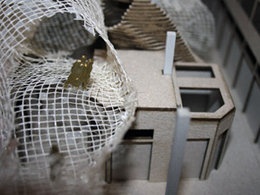STUDENTS PROJECTS
PROJECTS2012

26 May, 2013
Tracing the light and the wear
During the last decades Modiano Market has become a dynamic scope of light and decay, as a result of the gradual abandonment and decadence of the place.
Students: Zntravkov Irini, Keramida Sofia, Sourvinou Ioanna
Supervisors: Lada Anastasia, Papadimitriou Spiros
School of Architecture, A.U.Th.
Presentation date : 18th February 2012
During the last decades Modiano Market has become a dynamic scope of light and decay, as a result of the gradual abandonment and decadence of the place. This specific project's purpose is to investigate a site situated at the centre of the city, in accordance with the senses stimulated to the user, while a main concern is to spatially represent the atmospheres inscribed to it.

First of all it is crucial that we examine the atmospheres detected in the market and decode them through the elaboration of simulation models and diagrams. These models and diagrams assume scenarios of wear expansion and spatial interconnections between different levels of light. What is more, there is a great interest for the optical phenomenon of reflection that is dominant in the Market, considered as a consequence of the effect of light and materiality. It is desirable that we compose a mechanism that produces intensities, based on the architectural tools of "Force", "Folding", "Deform" and "Wear". During the whole research the diagrams feedback the mechanism and the models and vice versa. In order for this mechanism to result in spatial formations, it is deconstructed and then recomposed so that it defines a vocabulary.
Finally, there is the intention to reconstruct various atmospheres of light and materiality in the market. This is feasible through the interaction of the artificial mechanism mentioned above with the initial diagrams of light and wear made for the actual place of the market. Therefore, the "vocabulary" and its content are enriched with the particular features of the site such as the gradation and the direction of the light. As a result, four rooms are designed that address spaces of contrasting intensities. These spaces amplify the existing conditions of light and materiality, and highlight three specific periods of day-time. Furthermore, a mesh is developed at an upper level filtering out the light while at the same time unifying the underlying spaces.














